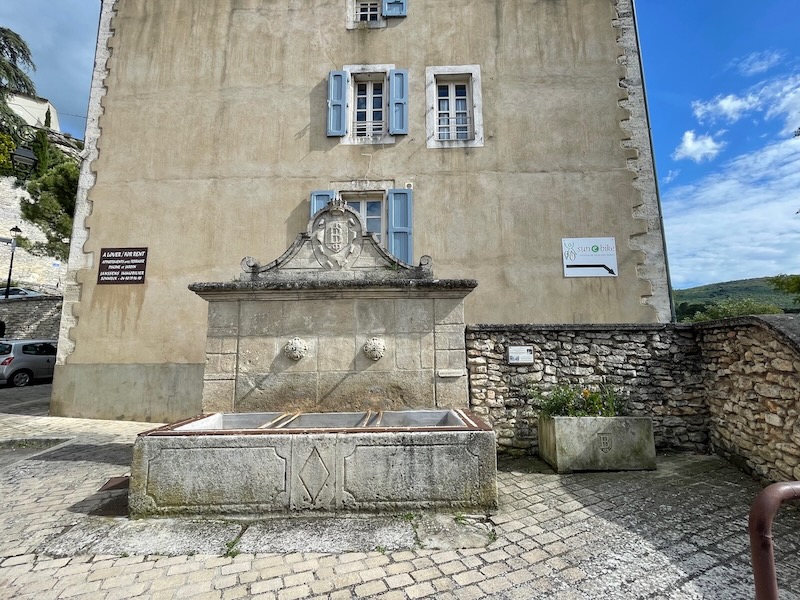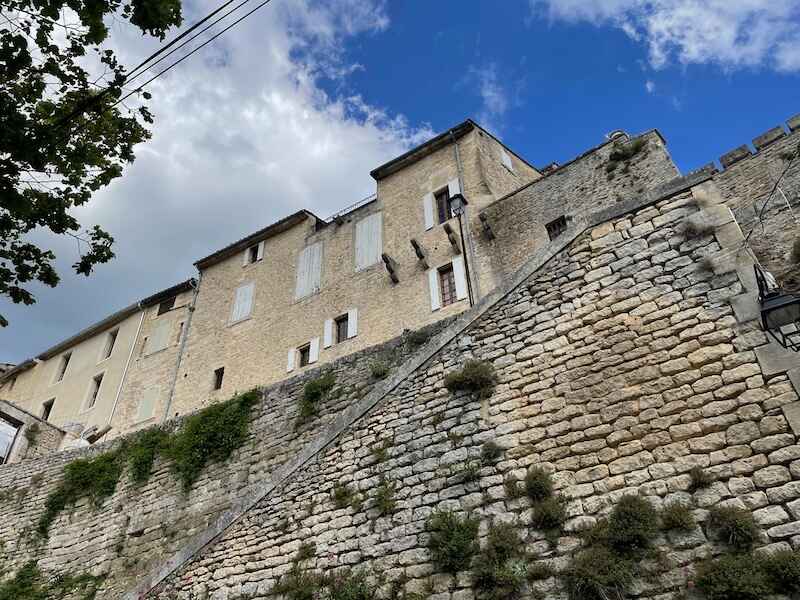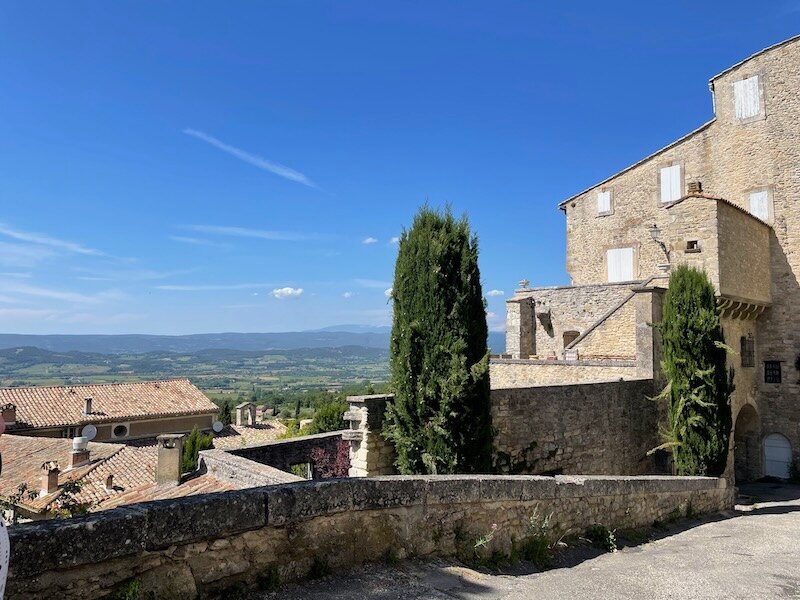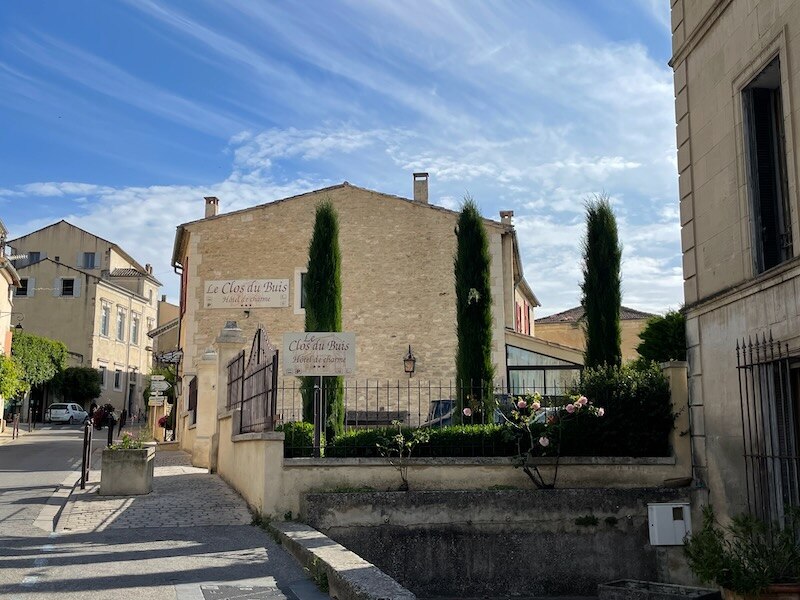Unsure about your French table manners? Click Here to download > > How to avoid these 10 food etiquette mistakes !
- Home ›
- Destinations ›
- Southern France ›
- Bonnieux
Bonnieux, France: Heart of the Luberon
Published 21 October 2024 by Leyla Alyanak — Parisian by birth, Lyonnaise by adoption, historian by passion
The Luberon is known for its stunning hilltop villages, but for me, Bonnieux stands out − I can't go more than a few months without a visit. It combines ancient stones with the lightest touch of modern life, and because it is located in the heart of the region, it is the perfect base from which to explore.
Try to time your arrival in Bonnieux for sunset, as the fading light dances wildly over the Petit Luberon. You can watch it from your window, or find a terrace with a view. If you’re lucky, perhaps you have a friend whose apartment faces West.
Here’s what you might see.
 A stunning Bonnieux sunset as seen in September ©OffbeatFrance
A stunning Bonnieux sunset as seen in September ©OffbeatFranceNOTE: Pages on this site may contain affiliate links, which support this site. See full Privacy Policy here.
Bonnieux is one of the loveliest and most historic villages of the Luberon, that mountainous stretch east of Avignon filled with some of the most famous hilltop villages in France.
But it is more than just a picturesque stop in the Luberon – Bonnieux is built on layers of history, where every stone step opens up a new view, forcing you to catch your breath over and over.
A morning routine
I visit Bonnieux regularly. I live about five hours' drive away, and as soon as the weather cools in my mountains (I live in the Jura), I find myself heading South.
Later in the mornings, after breakfast, I love walking up to the Place Gambetta for a second coffee, on the terrace of Le P’tit Coin des Gourmands which overlooks the valley. Or, if it's a bit later, an ice cream at Le Tinel.
In the distance, a wisp of fog sometimes hovers over the lavender fields and olive groves, and the silhouette of the Château de Lacoste, which at different times belonged to the Marquis de Sade and to Pierre Cardin, is recognizable against the sky.
I try to breathe in the warm Provençal air, but there’s a tinge of smoke. This is France, after all, so the smell of tobacco isn’t that unusual. The men crowd a few nearby café tables, puffing away their last moments of freedom before they return to work.
My work is different. I’ll drop by to see Annelie, a Finnish architect turned gallery owner. I hear she has some new paintings by my friend Janice Jacquet, whose work you can see on Instagram. And then I’ll pop across the lane to Mimi Bohème, because she’s having a sale and I need a new skirt, and I’ll wave at my friend Kathy Wood, who is about to embark on a day of sightseeing with European Experiences, the tour company she owns.
It may only be mid-morning, but already, the sounds of the kitchen are loud and steady at the newly opened Ju, Maison de Cuisine, which I have yet to try. For those of you who know Bonnieux, this is where the well-regarded l'Arôme was located for 18 years.
I hear the chef is none other than Julien Allano, the Michelin-starred former chef of the restaurant at the Clair de la Plume hotel in Grignan, whose cuisine I so enjoyed when I visited a few years ago.
 A memorable meal at the Clair de la Plume in Grignan, in the Drôme ©OffbeatFrance
A memorable meal at the Clair de la Plume in Grignan, in the Drôme ©OffbeatFranceMost days, when I’m here, I jump into my car and explore the Luberon far and wide – everything is within easy reach.
Today, though, I’m staying close to home.
Because it’s time I gave Bonnieux its due.
Bonnieux: An invitation to explore
Bonnieux was made for wandering.
Take any street and you’ll pass village houses solid with stone and brightened by blue shutters that keep out the midday sun. Their nooks and crannies are often hidden from view, perhaps behind discreetly gated gardens.
And you’ll climb. And climb. Each time you turn a corner, you’ll see stone steps or an uphill alley.
Here and there, a stone fountain – yes, stone again, so common in these parts – will welcome you with its freshness, and even if you can’t drink the water, you can wet your face with it on a hot summer day.
 On the 4 September square, the village fountain, decorated with the town’s coat of arms. The “lavoir”, or public wash basin, once stood across from it ©OffbeatFrance
On the 4 September square, the village fountain, decorated with the town’s coat of arms. The “lavoir”, or public wash basin, once stood across from it ©OffbeatFrance Bonnieux's "new" town hall, an old priory purchased by the village in 2009, which now houses the mayor's office and other village services, along with a separate room for ceremonies. The building is part of the Hotel Dieu, located on the lower, main street, which now houses the tourist office ©OffbeatFrance
Bonnieux's "new" town hall, an old priory purchased by the village in 2009, which now houses the mayor's office and other village services, along with a separate room for ceremonies. The building is part of the Hotel Dieu, located on the lower, main street, which now houses the tourist office ©OffbeatFrance Quiet alleys of Bonnieux, away from the center ©OffbeatFrance
Quiet alleys of Bonnieux, away from the center ©OffbeatFranceAlong the village ramparts, which separate the upper and lower towns, you’ll see the same sights others might have admired centuries ago, vast vistas that encompass mountains, groves, and other hilltop villages. Little has changed in centuries.
 Looking up at Bonnieux, one of the Luberon’s loveliest hilltop villages ©OffbeatFrance
Looking up at Bonnieux, one of the Luberon’s loveliest hilltop villages ©OffbeatFrance The town’s ramparts separate upper from lower Bonnieux. Everywhere you look, you’ll have exquisite views over the Luberon valley ©OffbeatFrance
The town’s ramparts separate upper from lower Bonnieux. Everywhere you look, you’ll have exquisite views over the Luberon valley ©OffbeatFranceBonnieux, France: The Romans were once here
One of Bonnieux’s most intriguing facets is its age, built as it is on the remains of a prehistory that later flourished as a Roman crossroads.
Gallo-Roman villas once dotted the approach to Bonnieux along the Via Domitia, opened in 3 BCE to connect Rome to Spain. Today, this important thoroughfare is remembered with stone plaques along what is now known as the D900, the road which crosses the Luberon.
If you love to visit Roman ruins in France, walk a few kilometers out of town and you’ll find the area’s wonderfully preserved Pont Julien. Cars were finally banned from it in 2005, but you can still cross it on foot or on a bicycle – not bad for 2000 years of constant use.
 The Pont Julien near Bonnieux is in remarkably good shape, given that it’s more than 2000 years old ©OffbeatFrance
The Pont Julien near Bonnieux is in remarkably good shape, given that it’s more than 2000 years old ©OffbeatFranceFast-forward to the Middle Ages and to the building of its 12th-century Old Church, once a Romanesque creation but now augmented by distinct 15th-century Gothic features. You’ll have to climb to the top of the village to see it but the views you’ll get when you reach the top (86 steps!) will make the sweat and tears worthwhile.
 A 13th-century oratory of the Virgin with child that sits near the Old Church at the top of Bonnieux ©OffbeatFrance
A 13th-century oratory of the Virgin with child that sits near the Old Church at the top of Bonnieux ©OffbeatFranceThe village later expanded and became a fortified stronghold, ruled by the Avignon Papacy. During the Wars of Religion, Bonnieux remained loyal to the Catholic cause as religious tensions gripped the region.
The village of Lacoste, almost next door, was the site of a brutal massacre by Protestant Huguenots.
And then there were the plagues that spread throughout Provence which, combined with the damage from the religious wars, would slow Bonnieux's recovery.
 Passage de la Juiverie, or Jewish Lane - under the Popes’ reign, Jews were tolerated in Bonnieux, living in this small enclave which was locked at night. In 1656 they were forced to leave ©OffbeatFrance
Passage de la Juiverie, or Jewish Lane - under the Popes’ reign, Jews were tolerated in Bonnieux, living in this small enclave which was locked at night. In 1656 they were forced to leave ©OffbeatFranceBonnieux’s trajectory changed dramatically with the French Revolution, after which the Papal States were dissolved and Provence joined France, ending nearly 500 years of Vatican rule.
The upheavals would hand Bonnieux a fate similar to that of many French villages: its houses would empty as a result of industrialization, which attracted people to cities.
The village's eventual revival would come with tourism, with visitors crowding the Luberon’s tiny villages, attracted by the wonderful medieval architecture and stunning views from the hilltops (and by books like those of Peter Mayle, which − for better or for worse − put the Luberon on foreign visitors' maps).
Moving with the times
Bonnieux hasn’t lost any of its historic charm, and the latest wave of “modernity” has done nothing to undermine its ancient feel.
There’s a “new” church − built in 1870. And yes, there are some modern things, like a few parking lots, a pharmacy, new restaurants. But you don’t get that “overdeveloped” feel. Renovations and restorations are tasteful, and where 21st-century touches cannot be avoided, they blend in easily with the rest of history.
But the push and pull of history does have its victims.
The village has lost its only newsagent, and to buy a lottery ticket you now have to drive to Apt. The Bakery Museum has closed.
And there’s a red light in town. Mind you, it regulates traffic along a street so narrow it was downright dangerous for two-way traffic, which included buses.
 The so-called “New Church” of Bonnieux (1870) ©OffbeatFrance
The so-called “New Church” of Bonnieux (1870) ©OffbeatFranceOn Friday morning, I get an early start. The sun has barely shown its face but there’s noise up the lane and sounds of things being shuffled around and unfolded.
It’s market day.
This is a typical Provençal market, but not one designed for tourists. There’s a small grocery shop in the village for essentials, but no supermarket, so the market is where locals come to buy their food for the week. I may be traveling, but I still leave with a basket of tapenade, a punnet of strawberries, and the most amazing truffle cheese I’ve ever tasted.
Friday is also the time to catch up with friends, have a coffee on the terrace, or an ice cream if it’s hot outside. Mind you, I get the sense every day is Friday in Bonnieux…
BONNIEUX'S CEDAR FOREST
Try to make time to visit this unique treasure, planted in the 19th century with Atlas Mountain seeds from Algeria and Morocco. This expansive forest has survived devastating fires: the cedars are naturally resilient, but they take so long to grow! The Atlas cedars can live hundreds of years if undisturbed − under the right conditions they can live to 1000. The forest's cool trails provide welcome shade in summer, and on a clear day, you can see all the way to Mont Ventoux.
Where to stay in Bonnieux
I’m sure there are plenty of lovely places to stay in Bonnieux but I have my two favorites.
The Clos du Buis is a lovely hotel (with swimming pool!) right at the town’s entrance, run by Pierre Maurin, who keeps saying he'll retire but is still running the hotel with his daughter Celine and assistant Sophie, ready with a bright smile to say good morning at their fabulous breakfast spread.
 The lovely hotel Clos du Buis in Bonnieux ©OffbeatFrance
The lovely hotel Clos du Buis in Bonnieux ©OffbeatFranceAcross the street is my other Bonnieux recommendation, perfect for a family or small group: Bonheur en Bonnieux, a roomy apartment for up to five guests in the heart of Bonnieux.
Bonnieux is my base of choice when I visit this region, whether I’m off to see the Luberon’s most popular villages or its less-visited ones. It’s easy to get to, and most of the Luberon’s best sights are within easy driving distance.
Before you go…
Bonnieux isn’t quite like other nearby villages.
It isn’t designed to attract − it just does.
There may be cars on the road below, but as you move uphill towards the old church, all that breaks the deep silence is a breeze against the trees.
 Local artist Janice Jacquet, whose paintings are exhibited throughout the region ©OffbeatFrance
Local artist Janice Jacquet, whose paintings are exhibited throughout the region ©OffbeatFrancePlenty of artists have elected to live here, and it is becoming something of a gastronomic destination, attracting chefs from across France.
Yet it isn’t sophisticated: Bonnieux is a village that lives at its own rhythm. The farmers below tend their vines and orchards, while shops and restaurants prepare to welcome the day’s visitors.
And in the evening, as the sun drops like a fireball over the horizon, I know that by deciding to call Bonnieux home, even one week at a time, I’ve made the right decision.
Did you enjoy this article? I'd love if you shared it!

